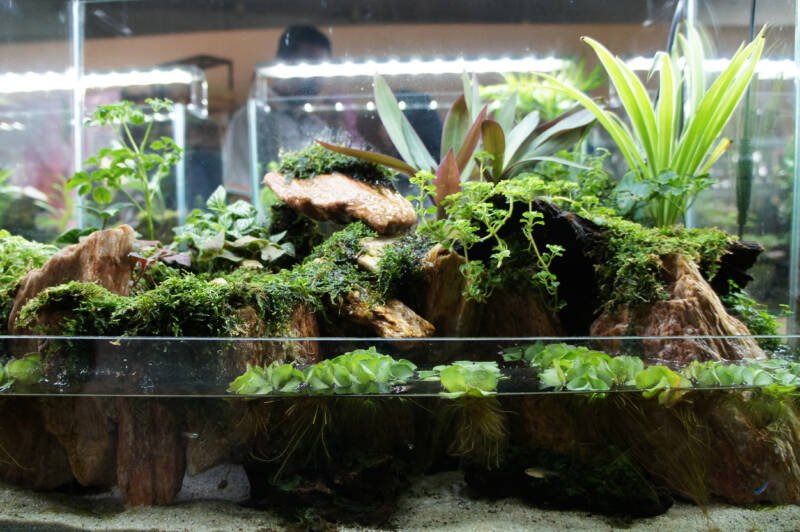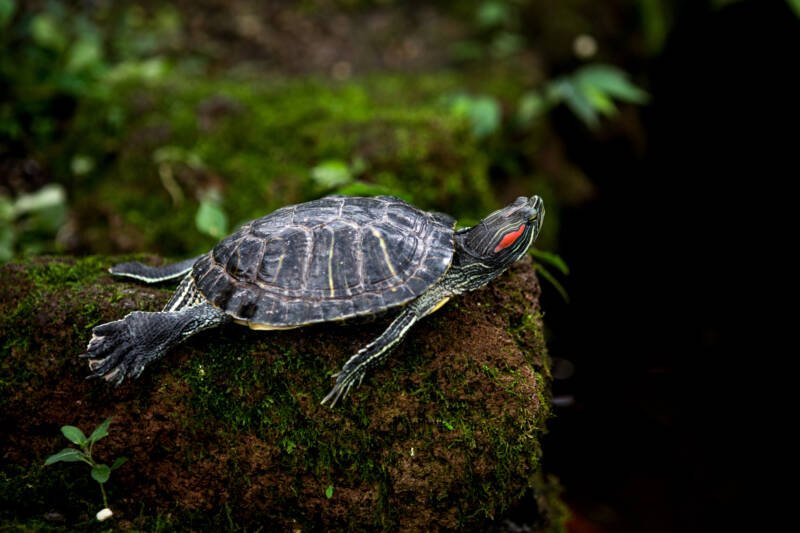With the rise in interest in the more advanced aspects of animal husbandry recently, a lot of folks have been fascinated with naturalistic terraria and paludariums.
Look around on social media, and you’ll see it: bioactive paludariums filled with assorted creatures cohabitating, leading to beautiful, abundantly verdant enclosures that are a feast for the eyes.

With this, many people are looking to see what they can accomplish within their homes and backyards.
Who wouldn’t want to look into an enclosure and see beautiful dart frogs jumping from leaf to leaf while a small bale of turtles basks in the light?
While this may sound fantastic, the reality is a little bleak.
Keeping turtles and frogs safely together is difficult, if not outright impossible, in most circumstances. As always, though, there are some exceptions.
I’ll cover some of the more common combinations of turtles and frogs kept together and the possible outcomes in those situations.
In this article
Can you Keep Turtles and Frogs Together?

Honestly? Kind of, but not without a chance of loss.
It’s a little more complicated than just throwing some bullfrog tadpoles in with your red-eared sliders. So I don’t recommend it to anyone but the most experienced hobbyists.
Both frogs and turtles are opportunistic predators. This means that as long as one is larger than the other and it has the opportunity, it will attempt to eat the other one.
Frogs and turtles both eat prey to survive. They both require animal protein and will always seek opportunities for it.
However, if kept in the proper environment and correct combination of species, there is a small chance of survival for both frogs and turtles.
The Proper Environment
One of the most important things to ensure survival for both frogs and turtles is keeping them outdoors.
You will have a higher likelihood of survival when you keep frogs and turtles together in an outdoor pond. Building a pond to keep them together offers the space necessary to build a safer environment.
This doesn’t mean there isn’t a chance of losses. There are some ways to decrease this chance, though.
How to Prevent Loss When Keeping Frogs and Turtles Together Outdoors
Lush Vegetation
Planting large amounts of vegetation to provide cover for both frogs and turtles to hide in is vital to increase their chances of survival when living together.
Elodea and hornwort are great aquatic plants that grow fast and provide tons of cover.
I also recommend native sedges or rushes for the pond shore to provide the frogs a place to flee to that’s hard for turtles to access.
Floating plants, like water lotus and water lilies, also provide a safe area for frogs to escape.
Escape Routes
Frogs are generally bad swimmers, and turtles are bad runners, jumpers, and walkers. Use this to your advantage. Provide safe areas for each to escape to.
Driftwood, pond stones, and other hardscapes can be used to create easy escape routes between the land and water feature you’re keeping turtles and frogs in.
Enough Food
A hungry animal is a hunting animal.
To prevent loss, ensure you keep your turtles and frogs well fed, providing a nutritious, balanced diet according to their specific needs.
Go Big When Planning their Habitat
Provide the largest habitat possible while maintaining low livestock levels. This will help guarantee each animal has enough space to establish territory.
You want fewer encounters between the two while also providing space to flee when it does happen.
Keep it Clean
Skim your pond, install an effective filter. You’ll have a higher chance of survival when you keep your pond clean.
Everyone is healthier in a clean environment, and turtles produce a lot of waste. If this was a frog-only pond, I would maybe recommend otherwise.
Factors to Consider When Choosing Species
There are several important factors to consider when choosing which frogs and turtles to keep together.
Size
The closer in size, the better.
Predation is much more likely to occur whenever one species is smaller than the other or can fit the other into its mouth.
Obtain frogs when they are mature and roughly equal in size to the turtle you wish to keep them with.
Preferred Environment
If both species of frog and turtle occupy the same space most of the time, chances of violent encounters increase.
Aim for frogs that spend more of their time out of water. Fully aquatic frogs are not a good choice.
Diet
Snapping turtles love to eat frogs, fish, and anything else that swims past.
Adult horned frogs love to eat anything that fits in their mouth. Both are examples of poor choices to cohabitate with other species.
Turtles love eating tadpoles, so expect any sort of frog breeding to be nigh impossible without direct intervention.
Compatibility of Common Frogs and Turtles
Can American Bullfrog and Turtles live together?
American bullfrogs are some of the largest available frogs in the trade. If there was a species that would be safe, it’s the American bullfrog.
American bullfrogs are relatively compatible with turtles of equal size. They’re quite voracious, though, so will absolutely eat immature turtles.
I recommend mature bullfrogs and mature red or yellow-eared sliders as a workable combination for frogs and turtles, kept in an outdoor pond where they’re indigenous.
This would require A LOT of SPACE to achieve, though, due to the size of both species when mature.
Can Mississippi Map Turtles and Frogs Live Together?
Mississippi map turtles are a common, lovely turtle in the trade.
They swim incredibly fast and spend the majority of their time in water.
Males only attain a size of 3.5-5 inches or roughly 9-13 cm.
I recommend male Mississippi map turtles with frogs of the same size. White’s tree frog could work due to their mostly arboreal nature and the Mississippi map turtle’s mostly aquatic nature and small size.
There is still a chance of loss, though. It would also require a very LARGE enclosure to accommodate the frog’s need to climb.
Can Pacman Frogs and Turtles Live Together?
No, Pacman frogs cannot live with turtles.
Pacman frogs eat anything and everything that comes across their path. If they can’t eat it and it moves, they’ll try to bite it.
Pacman frogs have sharp teeth and a strong bite, too. If they feel threatened, they will bite. This includes fingers, other Pacman frogs, and turtles.
Can Dart Frogs and Turtles Live Together?
No, dart frogs and turtles can’t live together. Dart frogs only attain a small size when mature, making a very good snack for most turtles.
Dart frogs are also poisonous if wild-caught. They can outright kill your turtle if consumed.
I recommend never purchasing wild-caught dart frogs in order to maintain healthy wild populations. There are many options available from many safe, environmentally-conscious breeders now.
Can Gray Tree Frogs Live with Turtles?
Maybe. Gray tree frogs live in areas where red and yellow-eared sliders are indigenous, so they can handle living near an outdoor pond with them.
However, the skin secretes a substance known to irritate sensitive areas of human skin. This may hurt your turtles, but it also may prevent them from seeing gray tree frogs as an easy meal.
Can Green Tree Frogs Live with Turtles?
No. This is due to the fact green tree frogs are incredibly sensitive species that have strict needs for their environment that cannot be accomplished outdoors unless you live in an area green tree frogs are native to.
Green tree frogs require a lot of climbing space, consistent high temperatures and humidity, and access to water. They also maintain a small size that makes them quite a good snack for turtles.
Green tree frogs should be kept inside, in enclosures. This alone prevents them from living with most turtles in your average pet keeper’s home.
Can Red-Eared Sliders live with Frogs?
Of all the turtles common to the pet trade, red-eared sliders have the most compatibility with frogs next to Mississippi map turtle males.
As red-eared sliders age, their diet becomes mostly herbivorous, as opposed to carnivorous.
If you obtain a mature red-eared slider or yellow-eared slider and feed them a balanced diet, they’ll have little interest in hunting frogs in their environment.
The only issue is acquiring frogs both large enough to make for a difficult meal and that won’t attack your turtles.
Conclusion
Overall, I do not recommend keeping turtles and frogs together.
Eventually, there will be losses. Watching a turtle eat a frog is a violent thing and terrible for all animals involved. Please, be humane and avoid this.
If you attempt to keep turtles and frogs together, one will eventually die a painful, avoidable death.
Please feel free to leave any comments or questions below. Have a great day and happy pet-keeping!